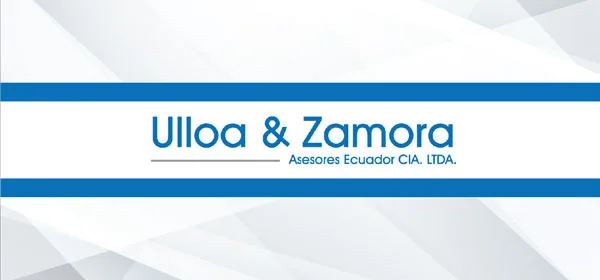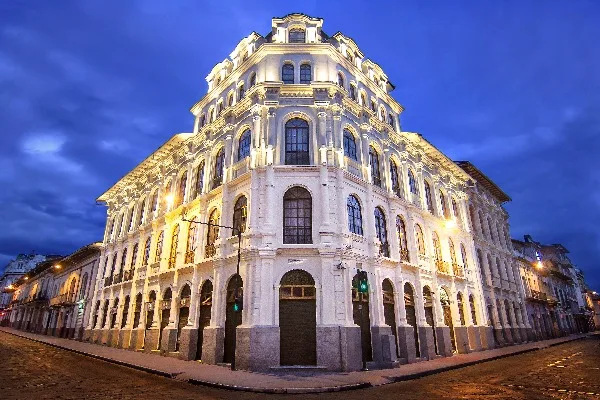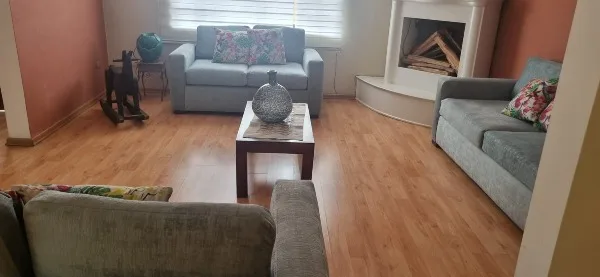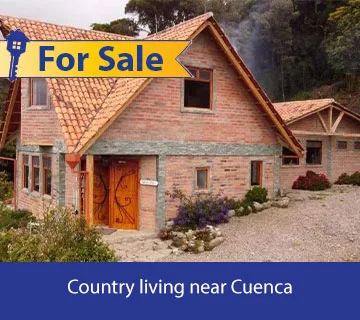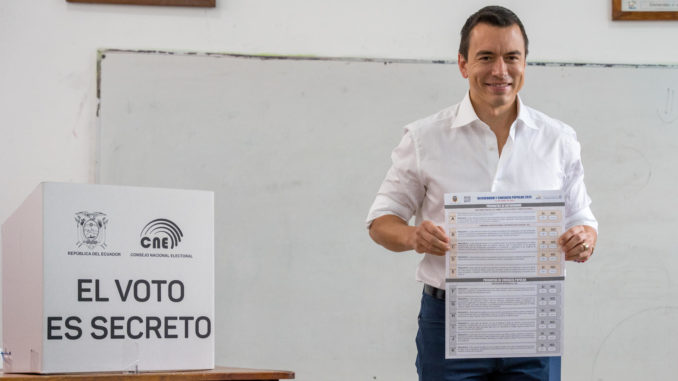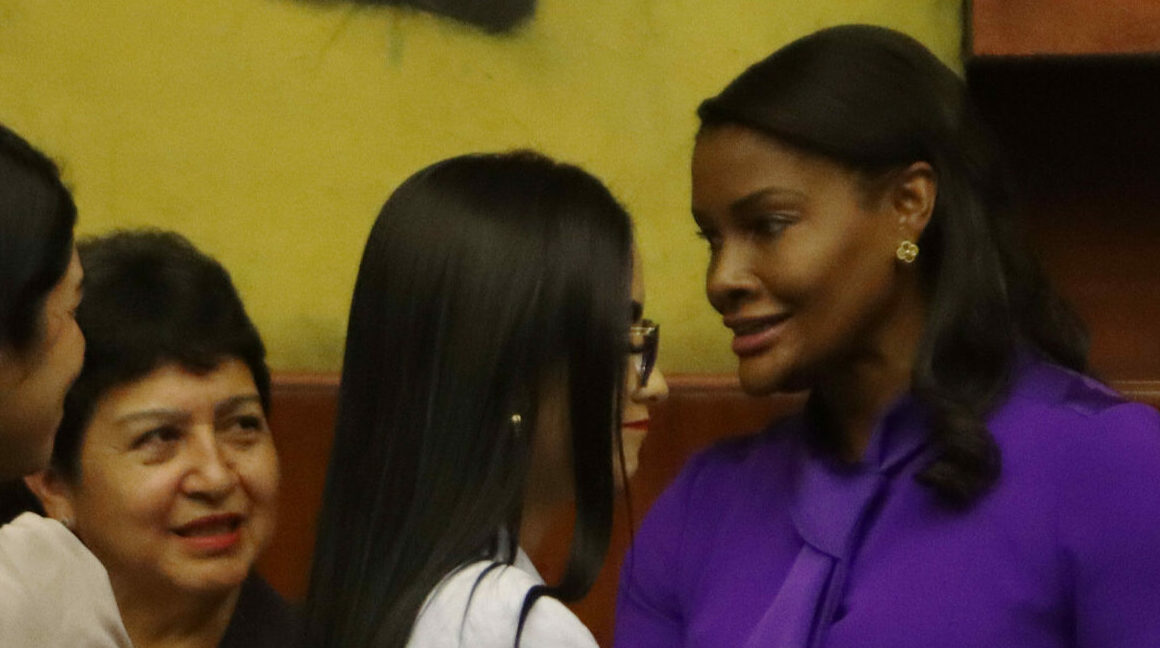#SOSEcuador: Explaining the national protests led by the indigenous movement

Indigenous protesters march last week in Quito.
By C.N.V. and L.E.S.
On October 2, Ecuador’s President Lenin Moreno announced an economic decree that brought the country to a social and economic crisis.
In March of this year, Moreno reached an agreement with the International Monetary Fund (IMF) that required him to cut government spending, among other IMF conditions, in order to receive a $4.2 billion dollar loan. To meet this commitment, he issued the “paquetazo,” a series of austerity measures meant to comply with IMF conditions. These measures removed decades-old fuel subsidies, among other reforms, spiking gasoline and diesel prices as much as 120% overnight and resulting in an increased cost of goods.
Fund (IMF) that required him to cut government spending, among other IMF conditions, in order to receive a $4.2 billion dollar loan. To meet this commitment, he issued the “paquetazo,” a series of austerity measures meant to comply with IMF conditions. These measures removed decades-old fuel subsidies, among other reforms, spiking gasoline and diesel prices as much as 120% overnight and resulting in an increased cost of goods.
This instantly triggered nationwide protests. The Ecuadorian Indigenous Movement demanded the annulment of the decree, pressuring the government by crippling the economy with mass marches, national strikes, road blockades, and the seizure of oil production facilities.
Citizens protested the neoliberal economic measures and extractivist policy that unjustly affect indigenous people, campesinos, and Ecuador’s working class. The majority of protesters were indigenous people who traveled hundreds of miles across the country, both by foot and in produce trucks. They came united alongside their community, which included elders, women, men, youth and children, to occupy the nation’s capital and speak on behalf of the entire nation.
The national protests responded to not only current events, but also to decades of political repression and economic, social, and environmental violence against indigenous people and their land. According to the CONAIE, the Confederation of Indigenous Nationalities of Ecuador, at least 40,000 protesters gathered in Quito, as well as 30,000 more nationwide, for the National Strike on October 9. The exact number of protesters is difficult to estimate, as road blockages and protesters paralyzed the country throughout the 12 days.
 The government responded on the first day of the strike with the historic measure of declaring a “State of Exception.” The right to assemble was revoked, media was censored and police and military violently repressed people’s right to protest. This repression resulted in at least eight confirmed deaths, over 500 injured people, nearly 1,000 people detained, and at least 100 disappeared people; unfortunately, these statistics continue to rise.
The government responded on the first day of the strike with the historic measure of declaring a “State of Exception.” The right to assemble was revoked, media was censored and police and military violently repressed people’s right to protest. This repression resulted in at least eight confirmed deaths, over 500 injured people, nearly 1,000 people detained, and at least 100 disappeared people; unfortunately, these statistics continue to rise.
The 12 days culminated with peace talks between the government and indigenous leaders moderated by the United Nations. Moreno ultimately repealed the decree, which was a significant victory for the Indigenous Movement. The government will now create a new decree in collaboration with indigneous leaders, as Ecuador’s debt to the IMF remains and its conditions need to be met.
Major media outlets backed the government throughout the conflict, failing to adequately report news, spreading misinformation, and ignoring various human rights abuses. The authorities also threatened and shut down various alternative media outlets that were covering the protests on the ground, such as Pichincha Universal FM.
This article attempts to draw from different sources of information beyond local and national mainstream news, such as social media and alternative news outlets. It also outlines a timeline of what happened during the past two weeks and contextualizes the protests within a wider history of indigenous resistance in Ecuador. Under continued censorship and a lack of adequate media coverage of what happened on the ground, this article condenses recent events, debunks misinformation, and denounces several human rights abuses that have happened thus far. International awareness and solidarity is urgently needed to pressure the Ecuadorian government to craft a fair agreement, seek justice, and end impunity for the countless human rights violations, torture, and assassinations of innocent people.
Brief History of the Indigenous Movement
The Indigenous Movement in Ecuador has a long-standing history. From colonialism, through the Republican Era, and into modern times, indigenous people in this territory have continually struggled for their basic rights, land, and recognition as equal citizens.
In the second half of the 20th century, the movement became more unified with greater political and social influence. None of the rights they have now were given freely by the government; they were fought for by the people. In the 1970s, the people pressured the government to recognize their ancestral lands. In the 1980s, the state reformed the education policy to include bilingual intercultural education, and the Indigenous Movement held multiple conferences to raise social and cultural awareness around the importance of native people. In the 1990s, the construction of the plurinational state began.
The 1990s were an emblematic moment for the movement. On June 4, 1990, indigenous communities from all over the country blocked streets and marched to highlight the discrimination and exploitation their people had endured since colonization. Their resistance tactics forced the government to dialogue with leaders and negotiate changes. This initiated a process of structural shifts towards indigenous rights and their integration into the political fabric of the country. Over the next few years, various government committees and offices began to include intercultural lenses in their work, as well as create new committees such as the “Committee of Nations and Peoples of Ecuador” and the “Office Of Indigenous Health.”
 This momentum continued, leading to mass mobilizations and the eventual removal of Presidents Abdala Bucaram in 1997 and Jamil Mahuad in 2000.
This momentum continued, leading to mass mobilizations and the eventual removal of Presidents Abdala Bucaram in 1997 and Jamil Mahuad in 2000.
Abdala Bucaram’s presidency is remembered for its neoliberal policies, corruption, and the fact that he was removed from office after being declared mentally unfit to rule by the National Congress of Ecuador.
Jamil Mahuad implemented IMF economic policies similar to those recently implemented by Moreno. He devalued the sucre, Ecuador’s national currency, by 15%, increased the price of gas by 71%, and raised the cost of electricity. The economy became unstable and banks showed signs of imminent collapse. In response, the government took over the debt of the banks. This created a grave economic recession in Ecuador that lead to mass unemployment, eventual dollarization, and the emigration of hundreds of thousands of Ecuadorians to Venezuela, Spain, Italy and the United States.
As previously mentioned, one of the main concerns of the Indigenous Movement is land rights. In the last few decades, including during the presidency of Rafael Correa, the country has been heavily concessioned to national and multinational oil and mining companies. Many indigenous communities have been impacted by the extractivist agenda; communities have been displaced, water sources polluted, and leaders criminalized and killed. For example, the mining project, Mirador-Cordillera del Condor, has displaced entire Shuar and campesino communities and polluted the rivers which were their main sources of water. Jose Tendetza, a Shuar leader who opposed the project, was murdered.
This is only one example of the many social and environmental conflicts that indigenous communities have been confronting for the past decades due to extractivist government policies.
The decades of struggle against the government, multinational companies, and imperialist policies set the tone for this latest clash. In the next section, this article outlines a timeline of the recent uprising, the most recent addition to this long history of indigenous resistance.
Timeline
May 2017: Lenin Moreno, running with the Alianza Pais political party, wins the election for the Ecuadorian presidency. Moreno, vice president to former President Rafael Correa, ran on a social-democratic, left-leaning platform, following in his predecessor’s footsteps. However, post-election, his policies begin to lean right and neoliberal, re-initiating relationships with the IMF and World Bank, international organizations that Correa had cut ties with.
March 2019: After extended talks, President Moreno signs an agreement that allows the Ecuadorian government to borrow $4.2 billion as a loan from the IMF. The deal requires the government to comply with certain conditions set by the IMF, such as cutting government spending.
Wednesday October 2, 2019: Moreno announces a package of neoliberal austerity measures (Decree 883) meant to reduce government spending to comply with the IMF’s conditions. This “paquetazo” cut government subsidies on gas that had been in place since the 1970s, causing gas prices to increase by up to 120% overnight. It also included measures that would have affected government employees; it would have laid off up to 10,000 more public employees by the end of the year, reduced salaries by as much as 20%, required employees to work one day without pay each month, and cut annual vacation days from 30 to 15 days.
 Thursday October 3, 2019: Transportation unions (taxis, trucks, and buses) call for a national strike to protest the increase in gas prices. Bus and taxi cooperatives throughout the country refuse service and block roads bringing the country to a standstill. The general public also participated in protests and roadblocks, protesting the inevitable price increases of goods and services due to the austerity measures.
Thursday October 3, 2019: Transportation unions (taxis, trucks, and buses) call for a national strike to protest the increase in gas prices. Bus and taxi cooperatives throughout the country refuse service and block roads bringing the country to a standstill. The general public also participated in protests and roadblocks, protesting the inevitable price increases of goods and services due to the austerity measures.
In response, President Moreno declares a “State of Exception,” allowing the government to suspend the rule of law in the name of the public good. This decree allows the government to suspend certain rights, such as the right to protest, and empowers the military to use increased force to disperse protests. It also allows the government to enter and raid homes without warrants. Moreno reiterates that he has no intention of repealing the new measures.
Moreno leaves Quito for Guayaquil for uncertain reasons.
Friday October 4, 2019: The national transportation strike continues until the night of the 4. Leaders announce that they are satisfied that their grievances were heard after the government said it would explore raising public transportation fares. During the day, national taxi drivers’ leader Jorge Calderón, as well as two regional transport officials, are detained for paralyzing the public service. Protests and road blockages from citizens of Quito continue into the night, but protests remain minimal.
Saturday October 5 – Sunday October 6, 2019: Over the weekend, protests within the Ecuadorian capital quiet down. However, indigenous groups from around the country begin to mobilize towards Quito on foot, in buses, and in caravans to protest the increase in fuel prices, as well as more than a decade of increased extractive activity on their ancestral lands. Indigenous people have expressed discontent and protested the policies of both Moreno and Correa due to their inability to find ways of funding government activities beyond the extraction of natural resources on their land.
Monday October 7, 2019: Thousands of indigenous people from communities all over Ecuador begin to arrive to the nation’s capital. Moreno, in an unprecedented move, temporarily relocates the headquarters of the Ecuadorian government to Guayaquil. Jaime Vargas, leader of the national Indigenous Movement CONAIE, tells Al Jazeera news he will not speak to the government until it agrees to repeal the reforms, reinstating petroleum subsidies.
 Tuesday October 8, 2019: Members of the nationwide indigenous resistance unite in Arbolito Park, a park near the Ecuadorian Cultural House (CCE). Conflict erupts just south of the park between the Indigenous Movement and Ecuadorian police and the military, as protesters begin to march towards the capital’s Historical Center. Members of the Indigenous Movement storm the unoccupied National Assembly building, temporarily taking it over. Protesters are heavily tear gassed and injured protesters are brought to improvised health centers in the park.
Tuesday October 8, 2019: Members of the nationwide indigenous resistance unite in Arbolito Park, a park near the Ecuadorian Cultural House (CCE). Conflict erupts just south of the park between the Indigenous Movement and Ecuadorian police and the military, as protesters begin to march towards the capital’s Historical Center. Members of the Indigenous Movement storm the unoccupied National Assembly building, temporarily taking it over. Protesters are heavily tear gassed and injured protesters are brought to improvised health centers in the park.
As conflict escalates, the government forces push protesters back toward the park with tear gas and buckshot, or lead bullets. As protesters retreat into the park, where children and elderly people have taken refuge, police fire tear gas into the park itself. The indigenous people are forced to evacuate and seek refuge in nearby universities such as Universidad Politécnica Salesiana (UPS) and the Pontificia Universidad Católica del Ecuador (PUCE). Simultaneously, police fire tear gas canisters onto the grounds of nearby hospitals, such as the Espejo Hospital and La Maternidad Isidro Ayora, to combat nearby protests. According to David Cordero Heredia, a law professor at PUCE, in an interview with Democracy Now, there are 83 people detained throughout the day.
Tuesday night, Moreno issued Executive Order 888, which confirms the temporary relocation of the government headquarters to Guayaquil, and announces a “toque de queda,” or curfew, prohibiting movement from 8 p.m. to 5 p.m. in “strategic locations,” such as spaces near government buildings, for the duration of the State of Exception. As police began to enforce this new decree, many people on the streets fell victim to police brutality, as documented in videos by multiple Facebook users.
 Wednesday October 9, 2019: Leaders of the Indigenous Movement call for a National Strike. The indigenous protesters in Quito march towards the historical center, joined by local supporters. Considerable protests are also held throughout the country, includingCuenca and Guayaquil. Confrontations with the police escalate in multiple places throughout Quito, such as the historical center and the area surrounding Arbolito Park. State forces use excessive amounts of tear gas and fire buckshot into the crowds, similar to what was seen on Tuesday. Enforcing the “toque de queda” two hours before the government-declared time, the police push protestors back to the universities, which are designated as safe zones for humanitarian aid. Then, the police fire tear gas into the campuses of both PUCE and UPS.
Wednesday October 9, 2019: Leaders of the Indigenous Movement call for a National Strike. The indigenous protesters in Quito march towards the historical center, joined by local supporters. Considerable protests are also held throughout the country, includingCuenca and Guayaquil. Confrontations with the police escalate in multiple places throughout Quito, such as the historical center and the area surrounding Arbolito Park. State forces use excessive amounts of tear gas and fire buckshot into the crowds, similar to what was seen on Tuesday. Enforcing the “toque de queda” two hours before the government-declared time, the police push protestors back to the universities, which are designated as safe zones for humanitarian aid. Then, the police fire tear gas into the campuses of both PUCE and UPS.
President Moreno briefly returns to Quito on Wednesday afternoon, but leaves again for Guayaquil on Wednesday night, in the midst of the most violent clashes. He says that dialogue has begun, and is already beginning to bear fruit, but there is no evidence that CONAIE, or any other representative from the Indigenous Movement, had been involved in this supposed dialogue.
PetroEcuador, the state oil company, announces that it has lost almost $24 million since protests began, and that production losses caused by the protests could reach 165,000 barrels of oil a day, or nearly one-third of total production. This is due to road blockages preventing the transportation of oil, as well as the seizure of many oil wells by indigenous communities in the Ecuadorian Amazon region.
Thursday October 10, 2019: CONAIE designates Thursday as a day of mourning for those who died due to police brutality in the last few days of protest. A vigil is held in CCE, which is located next to Arbolito Park, where the coffins of the fallen are presented.
Indigenous protesters detain seven police officers on Thursday morning, who had come to hand over the body of Segundo Inocencio Tucumbi Vega. Segundo was a community leader from the province of Cotopaxi, who died on Wednesday after being trampled by a police horse. Police officers ultimately elect to stay of their own free will. Leaders of the indigenous resistance release the detained officers to the United Nations Quito headquarters at 7 P.M.
Reporters from mainstream news channels in Ecuador, such as EcuaVisa and El Universo, come to the CCE to cover events for the first time. Previous media coverage on the grounds has been through alternative news sources and citizen journalism.
 Friday October 11, 2019: Friday came with unprecedented repression from police forces and the military. Beyond violent repression with tear gas and lead bullets, Facebook users publish videos of policemen wiring fences with electrical currents in the historical center of Quito, and water is cut off to the CCE and surrounding areas, where many protesters are staying. These new forms of repression only increase levels of indignation and rage among the protesters and their allies.
Friday October 11, 2019: Friday came with unprecedented repression from police forces and the military. Beyond violent repression with tear gas and lead bullets, Facebook users publish videos of policemen wiring fences with electrical currents in the historical center of Quito, and water is cut off to the CCE and surrounding areas, where many protesters are staying. These new forms of repression only increase levels of indignation and rage among the protesters and their allies.
Protesters from the Indigenous Movement ask to hold a symbolic gathering of the people in the National Assembly Building. As they arrived, police welcomed them while waving white flags to symbolize peace. Once they got closer, police suddenly began to tear gas everyone, including women and children who had come anticipating a peaceful event. There are reports that confirmed at least one child suffocated and died from the tear gas.
CONAIE dismisses various cases of misinformation from mainstream and independent news sources and sends out an official statement responding to President Moreno’s request for a dialogue. In this statement, they explain that they have been attempting to dialogue with the government for two and a half years without seeing any results, which suggests that this new attempt to dialogue lacks credibility. They also denounce the government’s repression during these protests. They cite the most recent statistics up until that point: 554 injured, 929 detained, 5 confirmed dead, and an undefined number of disappeared people. They end the statement saying, “We will be open to dialogue once the government repeals Decree 883.”
Saturday October 12, 2019: Women who are against the decree march from Arbolito Park toward the north of the city. The march is led by indigenous women but also includes Afro, mestiza and white women. They march collectively, while singing chants and standing in solidarity with one another.
Offices within the Office of the Comptroller were set on fire. This caused much controversy and speculation, as these offices contain important political legal documents. Some conspiracy theories suggest that the government was behind the attack, while others claim Correa supporters from the Indigenous Movement burned the offices. CONAIE denies affiliation with the fires.
As the day goes by, tension increases. At 2:30 p.m. the President announces that the curfew will begin at 3 p.m., giving the protesters only a half-hour to find a safe refuge. The military then announce an indefinite 24-7 curfew and movement restrictions throughout the entire country.
Due to the sudden implementation of an earlier curfew, thousands of protesters are left in the streets, desperately looking for a place to go. Once again, the CCE, PUCE, and UPS become places of refuge. Once inside, many protesters are trapped without access to hospital care, food, and water, as the news of the 24-hour curfew sinks in.

The police tear gas the protesters that continue to resist at Arbolito Park and those who flee inside CCE. The excessive amount of tear gas causes organizers to move wounded patients and vulnerable populations to the second floor of CCE to avoid suffocation. Ground zero expands to the university area a few blocks north of the CCE. Helicopters with tear gas, lead bullets, and patrolling police forces are constantly seen and heard. As the police approach the universities, medical students who were volunteering in the medical brigades leave campus to create a human shield between police and protesters. This brave gesture is seen as heroic and a catalyst for peace.
Major news outlets create an atmosphere of uncertainty where rumors flourish, due to their lack of reporting on abuses of power, human rights violations, and updates from leaders of the Indigenous Movement. There are rumors throughout the day that water for the entire city will be cut off, since the south of the city lost running water earlier in the day. Rumors also spread that the police will massacre everyone trapped inside CCE, and that the government will shut down cellular carrier services and internet access, so that protestors inside of CCE cannot record and publish what happens to inform others. Panic and fear ensues.
There is a call for a cacerolazo, where people make noise with pots and pans from their homes — a strategy to show solidarity with the Indigenous Movement and lack of conformity with the government — at 8 p.m. The noise of the pots and pans echoes throughout Quito and surrounding areas for more than an hour and raises the spirits of the thousands of exhausted and injured indigenous protesters.
Sunday October 13, 2019: Confrontations break out between military personal and protestors blocking various entrances to the city. A large military convoy filled with weapons and firearms tries to pass through road blockages in Pintag to reach Quito, a county about 30 kilometers southeast of the capital. Protesters try to impede its passage, to stop the weapons from reaching Quito and causing further deaths, leading to an extremely violent confrontation. This clash results in many critically wounded, including children. Part of the military convoy is later stopped by people in the overpass between the streets of Simon Bolivar and Autopista General Rumiñahui. Protesters in multiple sectors of the city have violent confrontations with the armed forces.
Helicopters continue to spray protesters with tear gas. Even though tensions are high, people from Quito continue to give donations to support the movement and sustain protesters. Strike supporters in Cuenca also collect food and other supplies.
For many days, there are talks of a dialogue between the government authorities and the Indigenous Movement, however there is no evidence of conversation. The United Nations and the Catholic Church organize and facilitate a dialogue for the afternoon. The Indigenous Movement states that they will agree to a dialogue only if it is broadcast live.
Both parties show up to the dialogue in a secret location, as the rest of the country watches. There are nine representatives of the Indigenous Movement including Jaime Vargas, Leonidas Iza, and Miriam Cisneros, as well as six representatives from the government, including the Minister of Finance, the Presidents of the National Assembly, the National Council of Elections and the Judiciary Council, the Attorney General, the Comptroller and President Lenin Moreno.
 The indigenous leaders are firm in their stance for the annulment of Decree 883. Leonidas Iza, among other leaders, describes how Decree 883 is a case of economic violence towards not just indigenous communities, but towards all rural and poor communities throughout the country. He stresses that those who would be impacted by the decree are the most impoverished people. He proposes many options to cut government spending and meet IMF requirements, such as the elimination of salarios vitalicios (lifelong salaries that ex-presidents and vice presidents). The leaders also call for the resignation of María Paula Romo and Oswaldo Jarrín in their roles as Minister of Interior and Minister of Defense due to their roles in the police and military brutality during the protests. The indigenous speakers mention that no real peace can exist until Jarrin and Romo resign.
The indigenous leaders are firm in their stance for the annulment of Decree 883. Leonidas Iza, among other leaders, describes how Decree 883 is a case of economic violence towards not just indigenous communities, but towards all rural and poor communities throughout the country. He stresses that those who would be impacted by the decree are the most impoverished people. He proposes many options to cut government spending and meet IMF requirements, such as the elimination of salarios vitalicios (lifelong salaries that ex-presidents and vice presidents). The leaders also call for the resignation of María Paula Romo and Oswaldo Jarrín in their roles as Minister of Interior and Minister of Defense due to their roles in the police and military brutality during the protests. The indigenous speakers mention that no real peace can exist until Jarrin and Romo resign.
On the government’s side, President Lenin Moreno states he is a man of principle and has not gone against what he believes. He mentions his concern about ex-President Correa’s possible role in the protests. The Minister of Finance stresses the economic loss the country has experienced since the protests began and suggests that the mafia and the wealthy would benefit if the decree was repealed.
After a first round of interventions from both sides, they take a “15 minute break” that lasts roughly two hours. Once the live transmission returns, the UN moderator, Arnaud Peral, declares that the parties have come to an agreement: Decree 883 will officially be repealed, and a new decree will be created with the participation of the Indigenous Movement.
Celebration breaks out in the streets throughout the country, notably in Arbolito Park and the universities where the Indigenous Movement hosted protesters.
Monday October 14, 2019: The Indigenous Movement, as well as many Quiteños, call for a massive minga, or communal work day, to clean the city. Due to the 12 days of resistance, protests, and police and military repression, the sector around CCE and Arbolito Park, as well as the historical center, looks like a war zone. Starting at 6 a.m., thousands of people work collectively with brooms, trash bags, and gardening tools. By around 3 p.m., the streets and interior of Arbolito Park and CCE have been thoroughly cleaned. Many will remember Arbolito as the park of resistance and of Ecuador’s indigenous nations.
The CONAIE holds one last press conference at 1 p.m. Indigenous leaders such as Jaime Vargas, Leonidas Iza, and Miriam Cisneros thank everyone who supported their struggle during these days. They express their gratitude to many actors: for the people who walked to Quito from various provinces of the country to pressure the government, CCE and the universities that housed them for multiple days, all the volunteers who helped cook, clean, and provide childcare, the medical brigades who saved the lives of many, the community of Quito that took to the streets and donated food, medical supplies, blankets, clothes and more. The leaders also urge people to remember what happened and to never forget the human rights violations that took place. The Guardia Indigena honors Jaime Vargas by gifting him a spear as a symbol of gratitude for his leadership and loyalty.
Tuesday October 15, 2019: Gasoline and public transportation costs return to pre-strike levels, before Decree 883 was announced. School and life “as normal” appears to resume.
Human Rights Violations
Under Ecuador’s State of Exception and “toque de queda” curfew, the state repressed protesters using excessive violence, violating human rights countless times. Moreno implemented the curfew five hours earlier than anticipated, with only a half-hour notice before it took affect. Measures such as this allowed the government to abuse their power and incite fear throughout the nation.
As detailed in the timeline, police and military gassed safe zones such as the humanitarian refugee centers for women and children at the universities, as well as makeshift medical centers and hospitals, including a maternity ward. The police and military used firearms, grenades, buckshot, tear gas, and vomiting agents against unarmed civilians over the course of the protests. Protesters collected the tear gas canisters used against them and noted that many expired in 2014, which makes the gas extremely toxic and dangerous, as the chemicals inside them break down into cyanide oxide, phosphenes and nitrogens.

The police and military detained and jailed several protesters, journalists, and indigenous leaders. In addition, the government continues to censor independent media outlets and mainstream media has completely ignored what is going on or misconstrued information. Authorities interfered with independent media sources and threatened to close their outlets and jail the head journalists. One of the countless examples of censorship of local news outlets who have been reporting what has been going on is detailed here, where the government ordered the suspension of independent news outlet Pichincha Universal.
Human rights organizations such as Amazon Frontlines, Surukuna, and many others released a report on the various human rights violations on October 7. They detail in their 33-page report multiple violations of rights, including: repression, abuse of authority, lack of human rights and due process, aggression towards journalists, and lack of justice and access to lawyers for the detained and disappeared. They, and many other organizations, such as Human Rights Watch and CONAIE, have publicly denounced the grave violations of human rights that have taken place throughout Ecuador. These are just a few of the numerous human rights violations that occurred during the national protest, and justice has yet to be seen.
Justice Looking Forward
Recent austerity measures combined with a long history of political repression sparked a 12 day national protest in Ecuador. Though this article focuses on the protests and events that occurred in Quito, the Indigenous Movement resisted Decree 883 throughout the country.
Although the decree was ultimately repealed, a certain victory for protesters, countless human rights violations and crimes occurred without repercussions. International solidarity is urgently needed to pressure the Ecuadorian government to respond to the crimes committed by police and military against civilians and ensure that the new decree takes the demands of the Indigenous Movement into consideration. In the words of the CONAIE, “We celebrate this victory, but this does not end until a comprehensive accord is finalized … we have not forgotten our activists, and we urge the United Nations (and other human rights organizations) to follow up on the criminalization of protest, for the injured and fallen. There is no true dialogue without social justice.”
__________________
Editor’s note: The authors have asked to be identified by their initials, not by their full names.
C.N.V. is an activist, youth worker, and artist at heart. She was born and raised in Quito and completed her undergraduate and graduate studies at Clark University in Worcester, Massachusetts and now is back in Ecuador working in an NGO focused on popular education.
L.E.S. grew up in a small town in Connecticut. She graduated from American University in Washington, DC with a Bachelor’s of Arts and Science in Sociology. She came to Ecuador in a study-abroad program and has been working in decolonial education at an NGO for two and a half years throughout Quito and the Amazon. In her free time, she loves to explore art and culinary scenes, play guitar, run, and make those around her laugh.






